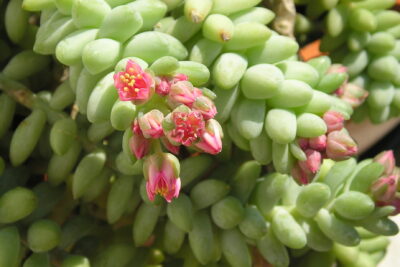
Exploring the Diversity: Succulents in Mixed Genus Categories

Succulents are a fascinating group of plants that have gained popularity among both indoor and outdoor gardeners. Known for their ability to store water in their leaves, stems, and roots, succulents come in a wide range of shapes, sizes, and colors. One interesting aspect of succulents is their diversity, which extends beyond their individual species to include mixed genus categories.
We will explore the concept of mixed genus categories in succulents, which refers to the practice of grouping different succulent species from various genera together. We will delve into the reasons why gardeners opt for mixed genus categories, such as creating visually appealing arrangements or enhancing the overall health and growth of the plants. Additionally, we will provide tips and ideas on how to create stunning mixed genus succulent displays, including considerations for selecting compatible species, balancing different growth habits, and ensuring proper care and maintenance. Whether you are a succulent enthusiast looking to expand your collection or a beginner wanting to experiment with mixed genus categories, this article will serve as a helpful guide to exploring the diversity of succulents in this unique context.
- Grouping succulents in mixed genus categories can create a visually appealing and diverse display
- It allows for a wider range of plant choices, as different succulent genera have unique characteristics and growth habits
- Mixing succulents from different genera can create interesting contrasts in color, texture, and form
- It provides an opportunity to showcase the variety of succulent shapes and sizes in one arrangement
- Succulents in mixed genus categories can create a dynamic and ever-changing display, as different plants may bloom or grow at different times
- It allows for more flexibility in design, as succulents from different genera can be arranged in various patterns or compositions
- Grouping succulents in mixed genus categories can be a fun and creative way to experiment with different combinations and discover new plant pairings
- It can be a practical solution for those with limited space, as mixed genus categories allow for more plants to be included in one arrangement
- By showcasing succulents from multiple genera, it promotes a deeper understanding and appreciation for the diversity within the succulent plant family
- It offers an opportunity to learn and study the different care requirements and characteristics of succulents from various genera
- Frequently Asked Questions
Grouping succulents in mixed genus categories can create a visually appealing and diverse display
Succulents are known for their unique and captivating beauty. Their diverse forms, colors, and textures have made them a popular choice among plant enthusiasts. While many people prefer to keep their succulents in separate genus categories, grouping them together can create an aesthetically pleasing and visually diverse display.
By combining different succulent species from various genera, you can create a stunning arrangement that showcases the beauty of each individual plant while also highlighting the contrasting characteristics of different genera. This approach allows you to experiment with different combinations and create an arrangement that is truly unique.
Benefits of grouping succulents in mixed genus categories
1. Visual Interest: Mixing succulents from different genera adds visual interest to your display. The contrasting shapes, sizes, and colors create a dynamic composition that catches the eye and adds depth to your arrangement.
2. Diverse Texture: Succulents are known for their diverse range of textures, from smooth and glossy leaves to spiky and rough surfaces. By combining succulents from different genera, you can create an arrangement that showcases a variety of textures, adding depth and tactile appeal to your display.
 Exploring the Possibility: Can Succulents Really Have Black Flowers?
Exploring the Possibility: Can Succulents Really Have Black Flowers?3. Blooming Patterns: Succulents from different genera often have different blooming patterns. By grouping them together, you can create an arrangement that blooms at different times of the year, ensuring that your display remains vibrant and colorful throughout the seasons.
4. Educational Experience: Grouping succulents from mixed genus categories can also provide an educational experience. By observing how different species interact and thrive together, you can gain a deeper understanding of their unique characteristics and requirements.
Tips for grouping succulents in mixed genus categories
- Consider growth habits: When grouping succulents, consider their growth habits, such as their size and spreading tendencies. This will help you create a visually balanced arrangement and prevent overcrowding.
- Pay attention to light requirements: Different succulent species have varying light requirements. Make sure to group plants with similar light needs together to ensure they thrive in their shared environment.
- Mix and match colors and textures: Experiment with different combinations of colors and textures to create a visually striking display. Pair succulents with contrasting leaf shapes and colors to create a balanced and harmonious arrangement.
- Consider watering needs: Succulents have different watering needs, so it's important to group plants with similar watering requirements together. This will help you avoid over or under-watering certain species.
By grouping succulents in mixed genus categories, you can create a captivating and diverse display that showcases the beauty and uniqueness of each plant. So go ahead, unleash your creativity and explore the endless possibilities that come with combining succulents from different genera!
It allows for a wider range of plant choices, as different succulent genera have unique characteristics and growth habits
When it comes to succulents, the world of possibilities is vast and diverse. Succulents are known for their ability to store water in their leaves, stems, and roots, making them resilient and low maintenance plants. One fascinating aspect of succulents is the wide variety of genera they belong to, each with its own distinct characteristics and growth habits.
Succulents in Mixed Genus Categories:
Exploring succulents in mixed genus categories can be an exciting endeavor for plant enthusiasts. By combining different succulent genera in a single category, gardeners and collectors can create stunning displays that showcase the beauty and diversity of these plants.
 Unveiling the Leafy Secrets of Succulents: Exploring Their Diversity
Unveiling the Leafy Secrets of Succulents: Exploring Their DiversityOne of the advantages of mixing succulent genera is the ability to create visually appealing arrangements with contrasting colors, textures, and forms. For instance, combining the rosette-shaped Echeveria with the spiky Aloe creates a captivating contrast that adds visual interest to any garden or indoor space.
Moreover, mixing succulents from different genera allows for a broader range of plant choices. Each genus has its own unique features, such as leaf shapes, growth habits, and flowering patterns. By including a variety of genera in a mixed category, gardeners can explore different forms, sizes, and colors, creating a dynamic and diverse plant collection.
Furthermore, succulents in mixed genus categories provide an opportunity to experiment with different care requirements. While succulents, in general, share similar traits, specific genera may have slightly different needs when it comes to sunlight exposure, watering frequency, or soil composition. By combining succulents from various genera, gardeners can learn more about the individual requirements of each plant and fine-tune their care routines accordingly.
Conclusion:
Exploring the diversity of succulents in mixed genus categories opens up a world of possibilities for plant lovers. From creating visually stunning arrangements to expanding plant collections with unique forms and colors, mixing succulent genera provides endless opportunities for creativity. So go ahead, dive into the fascinating world of succulents, and let your imagination run wild!
Mixing succulents from different genera can create interesting contrasts in color, texture, and form
When it comes to creating visually captivating succulent arrangements, exploring the diversity within mixed genus categories can result in stunning combinations. By blending succulents from various genera, you can create striking contrasts in color, texture, and form that add depth and intrigue to your indoor or outdoor spaces.
 Best Low-Light Cactus & Succulents for Indoor Spaces
Best Low-Light Cactus & Succulents for Indoor SpacesOne of the advantages of incorporating succulents from different genera is the wide range of hues available. Each genus brings its unique color palette to the mix, allowing you to play with an array of vibrant shades. For example, Echeveria varieties often display soft pastels, while Aloe species offer rich greens and oranges. By strategically combining these different color families, you can create captivating arrangements that catch the eye and add visual interest to any setting.
Texture is another element that can be enhanced by blending succulents from mixed genera. Some succulent genera, like Haworthia and Crassula, tend to have smooth, rounded leaves, while others, such as Agave and Euphorbia, feature spiky or architectural forms. By combining these different textures, you can create dynamic arrangements that not only look visually appealing but also provide a tactile experience for those who interact with them.
Furthermore, mixing succulents from different genera can result in fascinating variations in form. Some succulent genera, like Sedum and Sempervivum, produce compact rosettes, while others, such as Aeonium and Kalanchoe, grow in branching or cascading patterns. By incorporating these distinct growth habits into your arrangements, you can create visually captivating compositions that showcase the diversity of succulent forms.
Here are some ideas for mixing succulents from different genera:
- Create a vibrant centerpiece by combining Echeveria varieties with Aloe species. The soft pastels of Echeveria complement the vivid greens and oranges of Aloe, resulting in an eye-catching arrangement.
- Blend Haworthia species with Agave varieties to create a texturally diverse arrangement. The smooth, rounded leaves of Haworthia contrast beautifully with the spiky and architectural forms of Agave.
- Combine Sedum rosettes with Aeonium branching forms to create a composition that showcases both compact and cascading growth patterns.
Remember to consider the specific care requirements of each succulent genus when creating mixed arrangements. Some succulents prefer bright direct sunlight, while others thrive in partial shade. By understanding the needs of each genus, you can ensure that your mixed succulent arrangements not only look stunning but also remain healthy and thriving.
By exploring the diversity within mixed genus categories, you can unlock endless creative possibilities for your succulent arrangements. Whether you're a seasoned succulent enthusiast or just starting with these fascinating plants, experimenting with mixed genera will undoubtedly bring a fresh and captivating dynamic to your succulent collection.
It provides an opportunity to showcase the variety of succulent shapes and sizes in one arrangement
Succulents are known for their unique and diverse shapes and sizes, making them a popular choice for plant enthusiasts and gardeners alike. One way to truly appreciate the diversity of succulents is by creating mixed genus categories in your arrangements.
 Exploring Succulents: Discovering Flower-Like Varieties
Exploring Succulents: Discovering Flower-Like VarietiesBy combining different succulent species from various genera, you can create visually stunning displays that highlight the beauty of each individual plant. Whether you're a seasoned succulent lover or just starting to explore the world of these resilient plants, creating mixed genus categories provides an exciting opportunity to showcase their incredible variety.
Why choose mixed genus categories?
Creating mixed genus categories allows you to experiment with different colors, textures, and forms. It's like creating a masterpiece by combining different brush strokes and colors on a canvas. Each succulent brings its own unique characteristics to the arrangement, resulting in a visually dynamic and captivating display.
Additionally, mixing succulents from different genera can also be a practical choice. Some succulents have specific care requirements, and by combining them with others that have similar needs, you can create a more harmonious and manageable arrangement.
Tips for creating mixed genus categories
When creating mixed genus categories, it's essential to consider a few factors to ensure a successful and visually appealing arrangement:
- Contrast: Choose succulents with contrasting colors, textures, and shapes to create a visually striking display. Pair spiky succulents with rosette-shaped ones or combine plants with vibrant hues alongside those with muted tones.
- Size and Scale: Arrange the succulents in a way that creates a pleasing balance of sizes. Mix taller, upright varieties with trailing or sprawling ones to add depth and interest to the arrangement.
- Care Requirements: Consider the needs of each succulent before combining them. Ensure that they have similar light, water, and temperature requirements to ensure their health and longevity in the arrangement.
- Arrangement Style: Decide on the overall style you want to achieve, whether it's a compact and symmetrical arrangement or a more free-flowing and naturalistic design. This will guide your selection of succulents and their placement in the arrangement.
Remember, creating mixed genus categories is a creative process, so don't be afraid to experiment and let your imagination run wild. The possibilities are endless, and you're sure to discover new and exciting combinations that showcase the true diversity of succulents.
Succulents in mixed genus categories can create a dynamic and ever-changing display, as different plants may bloom or grow at different times
When it comes to succulents, the possibilities for creating unique and captivating displays are truly endless. One particular approach that has gained popularity among succulent enthusiasts is the concept of mixing different genera within a single category. This practice not only adds a touch of diversity to your collection but also creates a visually stunning and ever-changing display.
A Guide to the Most Common Types of Succulents and Care TipsWhy mix succulents from different genera?
Mixing succulents from different genera allows you to experiment with various shapes, colors, and growth patterns. By combining different plants, you can create a harmonious blend that showcases the diversity of succulents in a single arrangement. This approach not only makes your display more visually interesting but also offers a unique opportunity to observe the contrasting characteristics of different species.
1. Creating a dynamic display:
One of the main benefits of mixing succulents from different genera is the dynamic nature it brings to your arrangement. As different plants have distinct growth patterns and flowering seasons, your display will constantly evolve and change over time. This ever-changing nature keeps your arrangement fresh and exciting, providing a visually engaging experience for both you and your visitors.
2. Showcasing a wide range of colors and textures:
Succulents are known for their vibrant colors and unique textures, and mixing different genera allows you to showcase a wide range of these characteristics in a single arrangement. By selecting succulents with contrasting colors, you can create a visually striking display that catches the eye. Additionally, combining plants with different textures, such as smooth, spiky, or fuzzy, adds another layer of interest and dimension to your arrangement.
3. Learning about the diverse world of succulents:
Mixing succulents from different genera provides an excellent opportunity to learn more about the diverse world of these fascinating plants. By observing how different species interact and thrive together, you can gain a deeper understanding of their unique requirements and preferences. This knowledge can be invaluable in helping you care for and propagate your succulents more effectively.
 Dormant Succulents: Which Varieties Hibernate in Winter?
Dormant Succulents: Which Varieties Hibernate in Winter?4. Expressing your creativity:
Mixing succulents from different genera not only allows you to showcase their beauty but also gives you the chance to express your creativity. You can experiment with different combinations, arrangements, and container choices to create a display that reflects your personal style and aesthetic preferences. Whether you prefer a minimalist arrangement or a lush, overflowing display, mixing succulents from different genera gives you the flexibility to create something truly unique.
Exploring the diversity of succulents in mixed genus categories opens up a world of possibilities for creating captivating and ever-changing displays. By combining succulents from different genera, you can create dynamic arrangements that showcase a wide range of colors, textures, and growth patterns. This approach not only allows you to learn more about the diverse world of succulents but also provides an opportunity to express your creativity and personal style. So, why not embrace the beauty of succulent diversity and start experimenting with mixing different genera in your arrangements?
It allows for more flexibility in design, as succulents from different genera can be arranged in various patterns or compositions
Exploring the Diversity: Succulents in Mixed Genus Categories
When it comes to succulents, the possibilities for creating stunning arrangements are truly endless. One popular approach that has gained significant traction in recent years is the use of mixed genus categories. This method involves combining succulents from different genera to create visually appealing and diverse compositions.
One of the key advantages of utilizing mixed genus categories is the flexibility it offers in terms of design. By incorporating succulents from various genera, you can experiment with different shapes, colors, and textures, resulting in a truly unique arrangement. Whether you prefer a symmetrical pattern or a more organic and free-flowing composition, this approach allows you to let your creativity run wild.
 Diverse Native Succulents of Southern California
Diverse Native Succulents of Southern CaliforniaFurthermore, mixing succulents from different genera can also enhance the overall visual interest of your arrangement. By combining plants with contrasting characteristics, such as spiky Echeverias and rosette-shaped Haworthias, you can create a captivating display that draws the eye and keeps it engaged. The diversity in form and texture adds depth and dimension to your composition, making it a true showstopper.
Choosing the Right Succulents
When selecting succulents for your mixed genus categories, it is important to consider their individual needs and growth habits. Some succulents thrive in full sun, while others prefer partial shade. Similarly, certain species require more frequent watering, while others are more drought-tolerant. By understanding the specific requirements of each succulent, you can create a harmonious combination that ensures the long-term health and vitality of your arrangement.
Here are a few popular succulents from different genera that work well together:
- Echeveria elegans: With its rosette-shaped form and pale blue-green leaves, this Echeveria pairs beautifully with other succulents, adding a touch of elegance to any arrangement.
- Haworthia fasciata: Known for its striking white bands or stripes, this Haworthia is a fantastic choice to create contrast and visual interest in your mixed genus composition.
- Sedum morganianum: Commonly referred to as "Burro's Tail," this trailing succulent adds a cascading effect to your arrangement, creating a sense of movement and flow.
- Aloe vera: With its medicinal properties and vibrant green leaves, Aloe vera is not only visually appealing but also a functional addition to your mixed genus categories.
Remember, the key to a successful mixed genus succulent arrangement is to strike a balance between the diverse characteristics of each plant. By carefully selecting succulents that complement one another and taking into account their specific care requirements, you can create a visually stunning and thriving display that showcases the beauty and diversity of succulents.
Grouping succulents in mixed genus categories can be a fun and creative way to experiment with different combinations and discover new plant pairings
When it comes to succulents, there is a wide variety of species to choose from. Each succulent has its own unique characteristics, including size, color, shape, and texture. By grouping succulents in mixed genus categories, you can create stunning arrangements that showcase the diversity within this plant family.
One of the benefits of exploring mixed genus categories is the opportunity to experiment with different combinations. You can mix succulents with contrasting colors to create eye-catching displays or pair succulents with similar textures for a more cohesive look. The possibilities are endless!
 Discover the Diverse Range of Shapes and Colors in Succulent Varieties
Discover the Diverse Range of Shapes and Colors in Succulent VarietiesCreating a Succulent Collection
Before you start grouping succulents in mixed genus categories, it's important to have a well-curated collection. This means selecting succulents that thrive in similar growing conditions and have similar care requirements. By choosing succulents that are compatible, you'll increase the chances of success and create a harmonious arrangement.
To create a succulent collection, consider the following factors:
- Growing Conditions: Some succulents prefer full sun, while others do well in partial shade. Make sure to group succulents with similar light and temperature preferences.
- Watering Needs: Different succulents have different water requirements. Some like to be watered more frequently, while others prefer to dry out between waterings. Group succulents with similar watering needs to avoid over or under-watering.
- Size and Growth Habit: Consider the mature size of each succulent and their growth habits. This will help you plan the layout of your arrangement and ensure that each succulent has enough space to grow.
- Complementary Colors and Textures: When selecting succulents for your collection, think about how their colors and textures will complement each other. Mixing succulents with contrasting colors or combining ones with similar textures can create visually appealing arrangements.
Exploring Different Combinations
Once you have your succulent collection ready, you can start experimenting with different combinations. Here are a few ideas to get you started:
- Contrasting Colors: Pair succulents with bold and vibrant colors, such as Echeveria 'Lola' with Sedum 'Firestorm'. The contrasting hues will create a striking visual impact.
- Texture Play: Combine succulents with different textures, such as the smooth leaves of Haworthia with the spiky texture of Agave. The contrast in textures adds depth and interest to your arrangement.
- Size Variations: Create a dynamic display by grouping succulents of varying sizes. For example, place a larger Aloe in the center, surrounded by smaller Sedum varieties.
- Theme-based Arrangements: Create themed succulent arrangements by pairing succulents that evoke a specific aesthetic, such as a desert-inspired arrangement with cacti and other arid-loving succulents.
Remember, there are no strict rules when it comes to grouping succulents in mixed genus categories. Let your creativity guide you and have fun exploring the vast diversity of succulents!
It can be a practical solution for those with limited space, as mixed genus categories allow for more plants to be included in one arrangement
When it comes to creating stunning succulent arrangements, mixed genus categories offer a practical solution for those with limited space. These categories allow you to include a variety of succulent plants in one arrangement, making it a great option for those who want to explore the diversity of succulents.
With mixed genus categories, you can create visually appealing succulent arrangements that showcase different shapes, colors, and textures. Whether you prefer the spiky leaves of Echeveria, the rosette formations of Haworthia, or the trailing stems of Sedum, mixed genus categories allow you to combine these different succulent types to create a captivating display.
Benefits of Mixed Genus Categories
- Maximize space: One of the key advantages of mixed genus categories is that they allow you to maximize your space. Instead of having separate pots for each succulent variety, you can plant multiple succulents together in one container, making it ideal for those with limited space.
- Showcase diversity: By combining different succulent types, mixed genus categories provide an opportunity to showcase the incredible diversity within the succulent world. From the unique leaf shapes to the wide range of colors and textures, these arrangements allow you to appreciate the beauty of various succulent species in one place.
- Create visual interest: Mixed genus categories offer endless possibilities for creating visually interesting succulent arrangements. You can experiment with different combinations of succulents to achieve a harmonious blend of colors and textures, making your display truly eye-catching.
- Ease of care: Another advantage of mixed genus categories is that they can make succulent care easier. Since succulents in the same container have similar care requirements, it simplifies watering, fertilizing, and overall maintenance.
Whether you're a seasoned succulent enthusiast or just starting your succulent journey, exploring the diversity of succulents through mixed genus categories is a delightful way to appreciate their uniqueness. So, get creative and start experimenting with different combinations of succulents to create your own captivating mixed genus arrangement!
 Vibrant Green and Red Succulents: Perfect for Your Garden
Vibrant Green and Red Succulents: Perfect for Your GardenBy showcasing succulents from multiple genera, it promotes a deeper understanding and appreciation for the diversity within the succulent plant family
When it comes to succulents, many people are familiar with the popular genera such as Echeveria, Sedum, and Aloe. However, the world of succulents is vast and diverse, with numerous other genera that often go unnoticed. By exploring succulents from mixed genus categories, we can uncover a whole new world of stunning and unique plants.
One of the main advantages of showcasing succulents from multiple genera is the opportunity to discover the wide range of shapes, colors, and textures that exist within the succulent plant family. Each genus has its own distinct characteristics, making it a fascinating journey to explore the diversity across different genera.
1. Crassula
Crassula is a genus that includes a variety of succulent plants, ranging from small rosettes to sprawling shrubs. They are known for their thick, fleshy leaves and often have intricate patterns or vibrant colors. Some popular species within this genus include Crassula ovata, commonly known as the Jade Plant, and Crassula perforata, also known as the String of Buttons.
2. Haworthia
Haworthia is another fascinating genus within the succulent family. These plants are characterized by their thick, triangular-shaped leaves that grow in a rosette formation. Haworthias are often smaller in size and make great additions to indoor succulent collections. Some well-known species include Haworthia cooperi and Haworthia fasciata, also known as the Zebra Plant.
3. Kalanchoe
Kalanchoe is a genus that offers a wide range of succulent plants, many of which are highly ornamental and popular among collectors. These plants often have thick, waxy leaves and produce vibrant flowers in various colors. Kalanchoe blossfeldiana, commonly known as Flaming Katy, and Kalanchoe tomentosa, also known as Panda Plant, are just a few examples of the stunning species within this genus.
By exploring succulents from mixed genus categories like Crassula, Haworthia, and Kalanchoe, we can appreciate the incredible diversity within the succulent plant family. Each genus brings its own unique charm and beauty, offering a wide range of options for succulent enthusiasts to explore and enjoy.
It offers an opportunity to learn and study the different care requirements and characteristics of succulents from various genera
Introduction:
When it comes to exploring the world of succulents, one fascinating aspect is the vast diversity found within different genera. Succulents, known for their ability to store water in their leaves and stems, come in a wide range of shapes, sizes, and colors. Each genus has its own unique care requirements and distinctive characteristics, making them a captivating subject of study for succulent enthusiasts and plant lovers alike.
 Cascading Succulents: A Guide to Long and Trailing Varieties
Cascading Succulents: A Guide to Long and Trailing VarietiesUnderstanding Mixed Genus Categories:
Within the realm of succulents, there are often mixed genus categories, where a group of succulents from various genera are grouped together based on their similar care needs or characteristics. These mixed genus categories provide an excellent opportunity for succulent enthusiasts to explore and learn about different genera in a more comprehensive manner.
Benefits of Exploring Mixed Genus Categories:
By delving into mixed genus categories, succulent lovers gain a deeper understanding of the diverse range of succulents available. Here are some of the benefits of exploring succulents in mixed genus categories:
- Expanded Knowledge: Studying succulents from various genera allows you to expand your knowledge base and become familiar with a wider variety of plants.
- Care Insights: Each genus has its own specific care requirements, and by exploring mixed genus categories, you can gain valuable insights into the specific needs of different succulents.
- Visual Appeal: With mixed genus categories, you can create stunning arrangements that showcase the contrasting forms, textures, and colors of various succulents.
- Curiosity and Exploration: Exploring mixed genus categories sparks curiosity and encourages further exploration, as you discover new and intriguing succulents to add to your collection.
Conclusion:
Exploring succulents in mixed genus categories is an exciting journey that offers a wealth of knowledge and appreciation for the diverse world of succulents. By studying different care requirements and characteristics of succulents from various genera, you can enhance your understanding of these unique plants and create stunning displays that showcase their beauty. So, dive into the world of mixed genus categories and uncover the wonders that succulents have to offer!
Frequently Asked Questions
1. What are succulents?
Succulents are plants that have thick, fleshy leaves or stems which store water, allowing them to survive in arid conditions.
2. What is a mixed genus category?
A mixed genus category refers to a grouping of succulents that belong to different genera but share similar characteristics or growth habits.
3. Why are succulents popular in mixed genus categories?
Succulents in mixed genus categories offer a diverse range of colors, shapes, and textures, making them visually appealing and providing a unique and interesting display.
4. How should succulents in mixed genus categories be cared for?
Succulents in mixed genus categories generally have similar care requirements, including well-draining soil, adequate sunlight, and minimal watering to prevent root rot.
If you want to read more articles similar to Exploring the Diversity: Succulents in Mixed Genus Categories, you can visit the Varieties and Colors category.






You Must Read